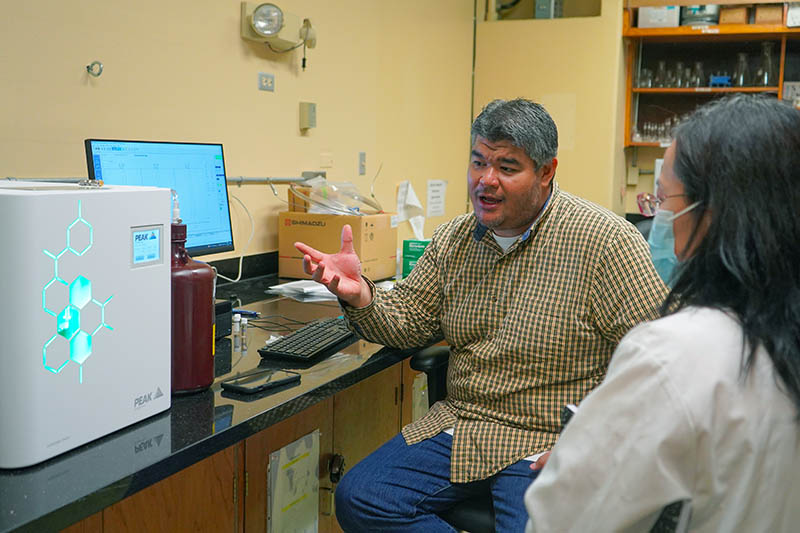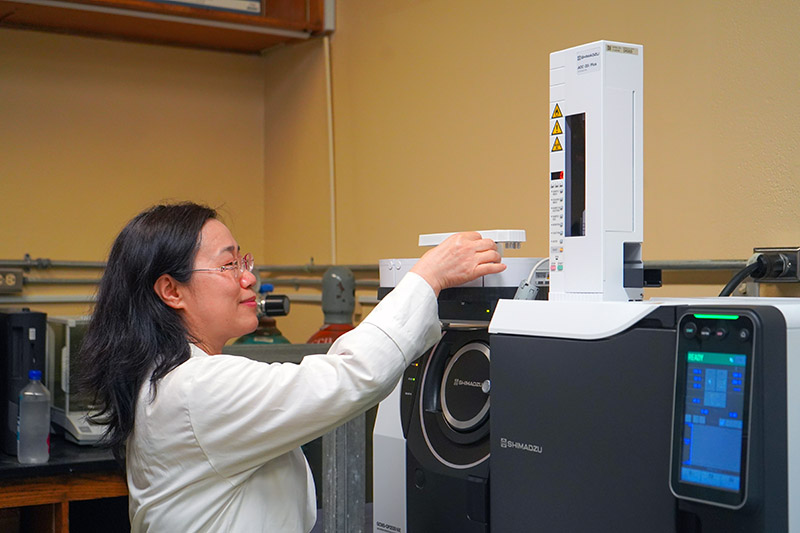New UOG chemistry lab instrument can identify unknown substances
New UOG chemistry lab instrument can identify unknown substances
New UOG chemistry lab instrument can identify unknown substances
6/23/2023
A new scientific instrument at the University of Guam is bringing a bit of a “CSI” vibe to the Chemistry Teaching & Instrumentation Lab in the Science Building.
Installed this past April, the Shimadzu-model gas chromatograph mass spectrometer, or GC-MS for short, is an analytical instrument that can separate complex chemical mixtures through the gas chromatograph (GC) process and conclusively identify the individual substances through the mass spectrometer (MS) process.
“The GC-MS instrument can analyze the sample and provide the identity and the quantity of the compound with a high degree of accuracy and precision,” said Dr. John Limtiaco, assistant professor of chemistry.
But more than creating the illusion of being a detective on a crime investigation television series, the instrument provides students with hands-on experience using a tool that is central to many professions. Additionally, it opens possibilities for researchers who can now conduct on-the-spot chemical analyses.
Classroom and workforce applications

At UOG, it will primarily be used for instruction in upper-level, instrumentation-based courses, including Organic Chemistry, Analytical Chemistry, Instrumental Analysis, and Forensic Chemistry. Eventually, the faculty hope to propose a master’s level chemistry program in which the GC-MS would be a key component.
“Incorporation of the new GC-MS will significantly enhance the teaching and learning effectiveness of [my Laboratory Techniques in Organic Chemistry] courses,” said Dr. Bulan Wu, associate professor of chemistry. “We can analyze both the product and side products through GC-MS, leading to a deep understanding of the reaction mechanisms.”
Five chemistry and one biology faculty have completed basic training so far for the GC-MS. Other departments and research centers at UOG will soon be invited to learn how to use it as well.
New research opportunities

“We can study pesticides, a wide range of volatile organic compounds, halogenated compounds, PCBs, PFOs, and PFAs,” he said, referring to various manmade chemicals. “Most of these compounds are regulated and require regular monitoring.”
Limtiaco, for one, is planning to use the instrument to investigate residual pesticide contamination on both local and imported produce and, in a separate study, investigate organic molecule transformations following seawater electrolysis. Wu said she plans to use the GC-MS for natural product research of local medicinal plants and herbs and to synthesize cannabidiol (CBD) and similar substances for anticancer activities.
A long-term goal for the GC-MS is to produce high-quality preliminary data that can be used to leverage large research grants.
Undergraduate and graduate students may utilize the GC-MS for individual research projects and laboratory experiments under the supervision of faculty or laboratory staff. Those interested may coordinate with Dr. Vuki at vukim@triton.uog.edu or Dr. Limtiaco at limtiacoj6850@triton.uog.edu.



